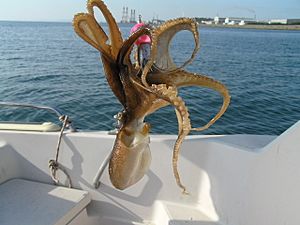Amphioctopus fangsiao facts for kids
Quick facts for kids Amphioctopus fangsiao |
|
|---|---|
 |
|
| Scientific classification | |
| Synonyms | |
|
The Amphioctopus fangsiao, also known as the webfoot octopus, is a type of octopus. It belongs to a group of sea animals called cephalopods. You can find this octopus in the Pacific Ocean. This includes areas near New Zealand, the Yellow Sea, and the coasts of China. People also catch this octopus for food, which is called commercial fishing.
These octopuses are often found in groups that are similar to each other based on where they live. They can also get sick from tiny living things called parasites.
Contents
Where Does the Webfoot Octopus Live?
This octopus lives in the Philippine Sea and the northwest Pacific Ocean. It is also found near the coast of Japan, for example, in Osaka Bay.
The webfoot octopus usually lives for about one year. They typically lay their eggs in the spring. After laying eggs, they continue to grow steadily. In a place called Haizhou Bay in the Yellow Sea, smaller webfoot octopuses are often found closer to the shore in spring and summer. Bigger octopuses tend to live further out in the sea.
Can Webfoot Octopuses Get Sick?
Yes, like many other sea creatures, the webfoot octopus can get sick. They can be infected by very small parasites. These parasites belong to a group called Aggregata. These infections have caused many webfoot octopuses to die in special farms in China. Another type of parasite, from the group Octopicola, has also been found in these octopuses.
When an octopus is infected with Aggregata, it might have many small white bumps, called cysts, all over its body. These cysts are very tiny.
How Are Webfoot Octopuses Related?
These octopuses are mostly found along the coasts of China. They have many different types of genes, especially in the Zhanjiang area. This means there's a lot of variety in their genetic makeup.
Scientists have found two main groups of webfoot octopuses based on their genes and where they live. One group lives along the northern coast of China, in places like Dalian and Qingdao. The other group lives along the southern coast, in areas like Wenzhou and Huizhou. Octopuses within each group are more similar to each other than to octopuses from the other group. This shows that their location affects their genetic differences.
Webfoot Octopus as Food
In Korea, the Amphioctopus fangsiao is called jukkumi (주꾸미) or jjukkumi (쭈꾸미). It's a popular food there. People often stir-fry it with a spicy sauce made from gochujang, which is a Korean chili paste.






